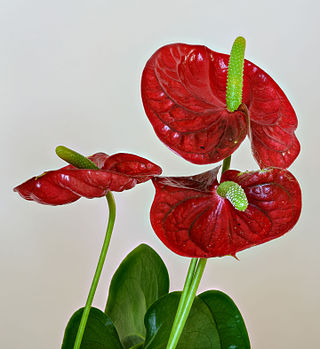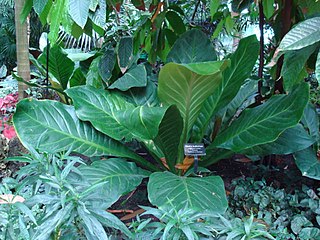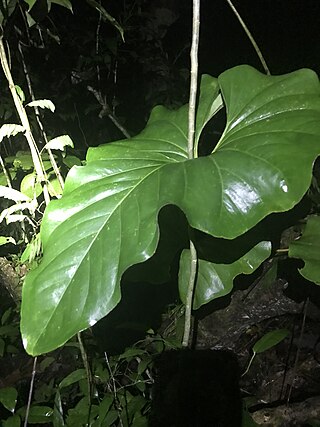
Fuchsia is a genus of flowering plants that consists mostly of shrubs or small trees.

Anthurium is a genus of about 1,000 species of flowering plants, the largest genus of the arum family, Araceae. General common names include anthurium, tailflower, flamingo flower, pigtail plant, and laceleaf.

Lamium galeobdolon, the yellow archangel, is a species of flowering plant in the mint family Lamiaceae. It is native to Europe and western Asia but it is widely introduced in North America and elsewhere. It is the only species in the genus Lamium with yellow flowers. Another common name for this species is golden dead-nettle. In New Zealand, it is called the aluminium plant or artillery plant. The common names archangel and dead-nettle have been in use for hundreds of years, dating back to at least the 16th century.

Dimorphandra is a genus of legume in the family Fabaceae, subfamily Caesalpinioideae. It includes 26 species native to northern South America, ranging from Colombia and Venezuela to Bolivia, Paraguay, and southeastern Brazil.

Ceroxylon is a genus of flowering plants in the family Arecaceae, native to the Andes in Venezuela, Colombia, Ecuador, Peru, and Bolivia, known as Andean wax palms.

Anthurium hookeri, commonly called a bird's nest anthurium, is a species of flowering plant in the genus Anthurium. Anthurium hookeri possesses some unique features which include, short internodes, dense roots, and lanceolate cataphylls. The leaves have triangular to D-shaped petioles 2–9 cm long, are rosulate, 10–26 cm wide, 35–89 cm long. The leaves exhibit a scalariforme venation and supervolute vernation. Covering the leaves are tiny black glandular punctuates. The berries produced by the plant are white.
Galium orizabense is a species of plants in the family Rubiaceae, named for the town of Orizaba in Veracruz, where the first collections of the species were made. The species is native to Mexico, Costa Rica, Guatemala, Panamá, Venezuela, Colombia, and Hispaniola, plus widely scattered locations in the southeastern United States.

Evodianthus is a genus of plants first described as a genus in 1857. It contains only one known species, Evodianthus funifer, native to Trinidad & Tobago, Central America and northern South America.

Anthurium crassinervium is a species of flowering plant in the family Araceae, native to Venezuela and Colombia in South America, and some Caribbean islands. It was first described by Nikolaus Joseph von Jacquin in 1791 as Pothos crassinervius and transferred to Anthurium in 1829 by Heinrich Wilhelm Schott.

Anthurium warocqueanum, commonly known as the Queen Anthurium, is a species of plant in the genus Anthurium. Native to Colombia, it is grown in more temperate climates as a greenhouse specimen or houseplant for its ornamental foliage.

Anthurium cubense is a species of flowering plant in the family Araceae, native to southeastern Mexico, Central America, Cuba, Colombia, and Venezuela. A large species, it is occasionally kept as a hothouse specimen or as a house plant. With Anthurium pendulifolium, it is a parent of the 'Big Bill' hybrid cultivar, with leaves exceeding 10 ft (3 m).

Anthurium brownii is a species of plant in the genus Anthurium native to Central and South America, from Costa Rica through Panamá, and south to Colombia, Ecuador, and Venezuela. First scientifically described in 1876, it was collected by Gustav Wallis and named for N. E. Brown. A. brownii grows from sea level up to 1,200 meters (3,900 ft) in tropical forests.

Anthurium clidemioides is a species of plant in the genus Anthurium native to Costa Rica, Panama, and Colombia. One of the more distinctive Anthuriums, it is a vining climber with almost stalkless, bullate leaves that can range from light to very dark green. Along with Anthurium flexile it is one of only two species in the genus that produces roots between nodes.

Anthurium coriaceum is a species of plant in the genus Anthurium native to southeast Brazil. A "bird's nest" type of Anthurium of the section Pachyneurium, it grows either terrestrially or epilithically in areas of seasonal dryness. It has erect leaves that feel like leather, which is where its scientific name derives from.

Anthurium jenmanii is a species of plant in the genus Anthurium. Growing as an epiphyte subshrub, it is native to South America from Trinidad and Tobago to Brazil. A member of the section Pachyneurium, and like related species it has a "birds nest" growth habit. It has a dark purple-black spadix and spathe, and produces red berries. In cultivation, it is commonly mistaken for Anthurium bonplandii subsp. guayanum, a related species.

Anthurium formosum is a species of plant in the genus Anthurium native to Central and South America. Epiphytic or terrestrial, it is found from Nicaragua to Colombia and northwest Venezuela.

Anthurium ernestii is a species of plant in the genus Anthurium native to South America. Found from southern Colombia to Peru and western Brazil, it typically grows below 500 metres (1,600 ft).

Anthurium argyrostachyum is a species of plant in the genus Anthurium native to Ecuador and Colombia. Growing as a small shrub or an epiphyte, it is best recognized by its foliage that has triangular or arrowhead-like shape, a long central lobe, and parallel veins. It is a member of the section Polyneurium, and is thus related to Anthurium corrugatum, Anthurium panduriforme, and others that share its parallel venation and other characteristics.

Anthurium obtusum is a species of plant in the genus Anthurium widely distributed in Central and South America, from Belize to Bolivia. The species was originally described as Anthurium trinerve by Adolf Engler and then in 1997, reclassified. The species is easily confused with Anthurium scandens, but can be distinguished by its terrestrial growth habit and a white spathe which stays erect rather than reflexed.

Anthurium wendlingeri is a species of aroid plant, in the genus Anthurium, found from Central to South America, from SE Nicaragua to NW Colombia. It grows in moist, montane tropical habitats as an epiphyte. Unique among its genus, A. wendlingeri has long, pendant and strap-like leaves, and can have a slightly velvety appearance.



















